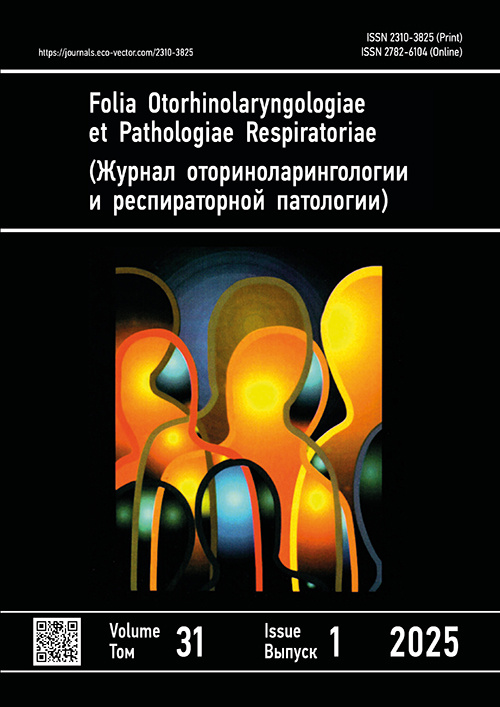Professional standards in treatment of acute inflammatory diseases of nasal cavity and paranasal sinuses for family doctors
- Autores: Nikitin K.A.1, Baranskaya S.V.1
-
Afiliações:
- Pavlov First Saint Petersburg State Medical University
- Edição: Volume 31, Nº 1 (2025)
- Páginas: 17-21
- Seção: Review
- ##submission.dateSubmitted##: 29.04.2025
- URL: https://journals.eco-vector.com/2310-3825/article/view/679025
- DOI: https://doi.org/10.17816/fopr679025
- EDN: https://elibrary.ru/RLMOYI
- ID: 679025
Citar
Texto integral
Resumo
Rhinitis is one of the most common conditions. Viruses are the main cause of inflammation of the nasal mucosa. In the development of the disease, bacterial infection joins or an opportunistic flora is activated. Therapeutic approaches include administration of antibacterial therapy if indicated (5–7 days for uncomplicated conditions, 10–14 days for complicated conditions), anti-inflammatory and mucolytic agents, non-steroidal anti-inflammatory drugs, decongestants, herbal drugs with proven anti-inflammatory effects. At the early stages, symptomatic therapy is indicated, including nasal irrigations with isotonic saline solution and both local and systemic decongestants. If there is purulent inflammation, local anti-inflammatory and antibacterial treatment can be added. One option is a silver solution. A 2% silver proteinate solution can be administered from early childhood as an antiseptic, disinfectant, and anti-inflammatory agent. The drug is effective in acute and chronic rhinitis, rhinosinusitis, and adenoiditis. Compliance with professional standards ensures effective treatment of acute inflammatory conditions of the nasal cavity and paranasal sinuses, reduces the risk of complications, and improves the quality of a patient’s life.
Palavras-chave
Texto integral
Sobre autores
Konstantin Nikitin
Pavlov First Saint Petersburg State Medical University
Email: nikinanin@mail.ru
ORCID ID: 0000-0001-8863-9236
MD, Dr. Sci. (Medicine)
Rússia, Saint PetersburgSvetlana Baranskaya
Pavlov First Saint Petersburg State Medical University
Autor responsável pela correspondência
Email: sv-v-b@yandex.ru
ORCID ID: 0000-0003-0871-3833
Código SPIN: 8830-5693
MD, Cand. Sci. (Medicine)
Rússia, Saint PetersburgBibliografia
- Babiyak VI, Hoffman VR, Nakatis YaA. Neuro-otorhinolaryngology. Saint Petersburg: Hippocrates; 2002. 727 p. (In Russ.)
- Boboshko MYu, Lopotko AI. Auditory tube. Saint Petersburg: Spetslit; 2003. 360 p. (In Russ.)
- Blotsky AA, Karpishchenko SA. Emergency conditions in otolaryngology. Saint Petersburg: Dialogue; 2009. 175 p. (In Russ.)
- Zvereva NN. Infectious and inflammatory diseases of the nasopharynx and paranasal sinuses in acute respiratory infections. RMJ. 2014;22(25):1854–1857. EDN: THWNKN (In Russ.)
- Kulsky PA. Silver water. Kyiv: Naukova Dumka; 1987. (In Russ.)
- Nikitin KA, Shavgulidze MA, Gerasimova EB. Othorhinolaryngologic complications of ARVI in family practice. Medical Council. 2013;(1-3):15–19. EDN: RURJKB
- Pluzhnikov MS, Diskalenko VV, Lavrenova GV, Glukhova EY. Handbook of otolaryngology for general practitioners. Saint Petersburg: Dialogue; 2002. 448 p. (In Russ.)
- Savadyan ESh, Melnikova VM, Belikov GP. Modern trends in the use of silver-containing antiseptics. Antibiotics and Chemotherapy. 1989;34(11):874–878. (In Russ.)
- Sichinava IV. Protargol in the treatment of rhinosinusitis in children. RMJ. 2015;23(14):844–846. (In Russ.)
- Soldatov IB. Guide to otolaryngology. Moscow: Medicine; 1997. 608 p. (In Russ.)
- Extended-spectrum β-lactamases — rapidly spreading and underestimated problem. Clinical microbiology and antimicrobial chemotherapy. 2005;7(1):92–96.
- Shuster MA, Kalina VO, Chumakov FI. Emergency care in otolaryngology. Moscow: Medicine; 1989. 303 p. (In Russ.)
- Lansdown ABG. Silver in health care: Antimicrobial effects and safety in use. Curr Probl Dermatol. 2006;33:17–34. doi: 10.1159/000093928
- Brett DW. A discussion of silver as an antimicrobial agent: alleviating the confusion. Ostomy Wound Manage. 2006;52(1):34–41.
- Tilton RC, Rosenberg B. Reversal of the silver inhibition of microorganisms by agar. Appl Environ Microbiol. 1978;35(6):1116–1120. doi: 10.1128/aem.35.6.1116-1120.1978
- Trevors JT. Silver resistance and accumulation in bacteria. Enzyme Microb Technol. 1987;9(6):331–333. doi: 10.1016/0141-0229(87)90054-8
- Karpishchenko SA, Nikitin KA, Baranskaya SV. Nasal decongestants in the treatment of nasal obstruction. Folia Otorhinolaryngologiae et Pathologiae Respiratoriae. 2022;28(4):4–9. doi: 10.33848/foliorl23103825-2022-28-4-4-9 EDN: TFURLW
Arquivos suplementares









